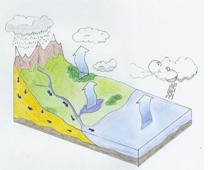|
|
 |
|
|
|
 |
| |
|
|
 |
Clouds & Particles
Basics |
Water in the atmosphere
Water is the only substance that can exist naturally in three 3 forms: as a liquid (in oceans, rivers, lakes..), as a solid (as ice, snow, hail..) and as a gas (as water vapour).
The atmosphere isn't just made up of air but also contains water vapour. This water vapour is invisible, doesn't smell and makes up less than 0.001% of all the water on the Earth. However, this tiny amount of water in the air is really important to our climate.
Let's now look at the role of water in the air and see what are clouds made of.
|
|
|
|
|
 |
|
The water we drink is water in its liquid state. When we crunch an ice cube, our teeth know that the water is solid. These two forms of water are easy to see. But water can also exist as a gas in the air, here the water occurs as free water molecules. We call these free molecules water vapour or moisture.
When liquid water is converted into water vapour, the process is called evaporation. This is what happens when you use a hair drier to dry your hair. The water doesn't simply disappear, it's still in the room but now in the air. Due to the high temperature of the hair drier, the liquid water has changed to water vapour, it has evaporated!
|
|
Condensation is the opposite process where water vapour changes to liquid water. After having a bath, the bathroom is filled with steam, or water vapour. The warm steam condenses onto the cold bathroom mirror, returning the water to it's liquid state and forming water droplets on the mirror. |
 |
 |
|
1. Condensation and evaporation. Author: J. Gourdeau.
|
Although many clouds look very solid, you could never walk on one. Clouds are only water in the air! Clouds form when water vapour turns into liquid water droplets or into solid ice crystals which are light enough to float in the air. The temperature at which water vapour condenses into visible water droplets is the saturation point. So the saturation point is the moment when condensation occurs or when dew forms. Cloud formation doesn't just involve cooling, however. In order to form clouds, water vapour needs to condense onto tiny particles in the air. These tiny particles are known as cloud condensation nuclei and we will look at how these particles help cloud formation in Unit 2.
|
 |
 |
 |
|
2. Source: C. Gourbeyre.
|
|
|
In some clouds the tiny water droplets collide and form larger water droplets. As the droplets become bigger and bigger (their volume increases about a million times during this collision process) they become too heavy for the air to support them and they fall as precipitation. Precipitation is the proper term for water which falls out of clouds, it can be rain, or snow, or hail.
|
 |
Clouds which occur in air which is below 0°C are made of ice crystals. These ice crystals form near droplets of super-cooled water (water that remains as liquid even when the temperature is below 0°C) and increase in size when water vapour from cloud droplets is deposited on the ice crystals. As the ice crystals fall, they can collide and this makes the ice crystals heavier. When the ice crystals are too heavy to float in the air, they fall to the ground. The crystals become snow or melt and become rain if the air below the cloud is more than 0°C.
|
3. Ice crystals (© Rasmussen and Libbrecht , Y. Furukawa, www.snowcrystals.com) |
Water Cycle
Water on the Earth moves in a continuous cycle. It's weird but true, we drink the same water that the dinosaur drank!
You now know that liquid water evaporates from the oceans forming water vapour. This water vapour then rises, cools and condenses into clouds. These clouds move over the land and rain falls out of some of them. The water which falls fills the lakes, streams and rivers and eventually flows back into the oceans. Once back in the ocean, evaporation starts the process all over again. Water also falls directly onto the land (about 11% of the water which falls) and moves through the soil ending up in the rivers adn the oceans. Some of the water which falls on the land is taken up by plants. The water moves from the roots, through the stems to the leaves where it can evaporate. This process is known as transpiration and is another important part of the water cycle.
|
 |
 |
 |
|
4. The water cycle. Author: J. Gourdeau. Click to enlarge (21 K).
|
|
About this page
author: Dr. Justine Gourdeau - LaMP, Clermont-Ferrand, France
scientific reviewer: Dr. Karine Sellegri - LaMP, Clermont-Ferrand, France
date of generation: 2003-08-26
|
|
 |
|







